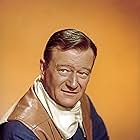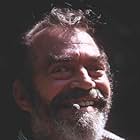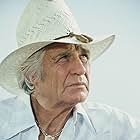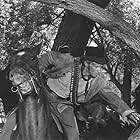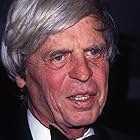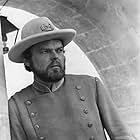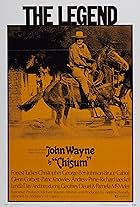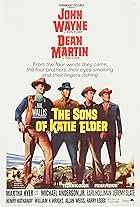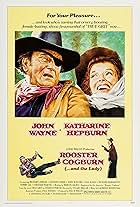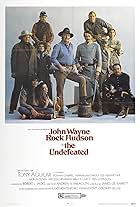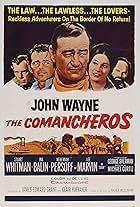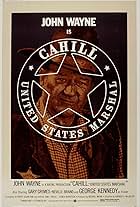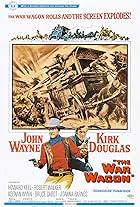AVALIAÇÃO DA IMDb
6,7/10
14 mil
SUA AVALIAÇÃO
Após a Guerra Civil, Cord McNally procura o traidor cuja traição levou à derrota de sua unidade guerreira e à perda de um amigo próximo.Após a Guerra Civil, Cord McNally procura o traidor cuja traição levou à derrota de sua unidade guerreira e à perda de um amigo próximo.Após a Guerra Civil, Cord McNally procura o traidor cuja traição levou à derrota de sua unidade guerreira e à perda de um amigo próximo.
Enredo
Você sabia?
- CuriosidadesRobert Mitchum visited his son Christopher Mitchum during filming. Director Howard Hawks asked the elder Mitchum to reprise his El Dorado (1966) role as a drunken sheriff, but Mitchum claimed he was now retired. John Wayne responded, "Mitch has been retiring ever since the first day I met him."
- Erros de gravaçãoWhen uncoupling the train from the locomotive the rebels pull up on a lever opening the knuckle coupler and releasing the car. At the time of the Civil War railroads used a link and pin coupling system. The knuckle coupler was invented by Eli Janney in 1873, eight years after the civil war ended. They are still in use today.
- Citações
Cord McNally: Do you think you could sneak up on the fella at the gate?
Phillips: I could sneak up on a *coyote* if I've a mind to!
Cord McNally: Did you get that fella at the gate?
Phillips: He's at *another* gate now, lookin' fer *Saint Peter*!
- ConexõesFeatured in Plimpton! Shoot-Out at Rio Lobo (1970)
Avaliação em destaque
Released in 1970, Howard Hawks' "Rio Lobo" starts with a thrilling Confederate train robbery of a Union gold shipment. After the war, Col. McNally (John Wayne) befriends Confederate Capt. "Frenchie" (Jorge Rivero) and his sergeant (Christopher Mitchum) to try to track down the Union traitors indirectly responsible for the gold robberies and the death of his close comrade and spiritual son. The trail leads to the West Texas town Rio Lobo and a showdown.
POSITIVES:
The opening credits features an exceptional two-guitar piece by Jerry Goldsmith with the camera zeroed-in closely on an acoustic guitar and the guitarist's hands. Sometimes I put the movie on just to see this part. The following half hour involves an excellent Confederate train robbery followed by the ensuing conflicts, which really make the film stand out from other Westerns. It's a great sequence, convincing and original. Civil War devotees should seek out "Rio Lobo" just for this.
Three notable women are featured: Jennifer O'Neill, Susana Dosamantes and Sherry Lansing, the latter of whom went on to became president of 20th Century-Fox and, later, chairman of Paramount Pictures (she's the scarred girl Wayne more or less rides off into the sunset with). I've heard jokes/comments over the years about the number of babes in the town of Rio Lobo, most single. But, really, there's only two in the town: Maria (Susan), who is seeing Frenchie's comrade (Mitchum), and Lansing, who isn't all that exceptional anyway; O'Neill was just passing through as part of some snake oil show.
The protagonists have good chemistry and camaraderie. The film was made right after the advent of the Spaghetti Western, which was known for amorality and lack of character depth. The protagonists in Italo Westerns were almost always antiheroes rather than heroes and caricatures rather than characters. They were grim, silent, one-dimensional killing machines, usually with dubious motivations (greed, revenge, lust) and just all-around comic-booky. While these types of characters are great when you're 13-20, they don't cut it when you're an adult and require more depth and realism. Don't get me wrong, the Spaghetti Westerns added (or perfected) a cool new style and grim sense of realism to the Western, but they accomplished this at the expense of morality, character depth and social realism. This explains why Clint Eastwood combined elements of both to forge the exceptional "The Outlaw Josey Wales" in 1976 after the decline of the Italo Western. Needless to say, it's nice to have a group of likable characters in "Rio Lobo" that get along and for whom you can root.
An exceptional example of this good-natured camaraderie is shown in the middle of the film before the protagonists reach Rio Lobo. McNally, Frenchie and Shasta are camping out in the desert where a running joke starts concerning McNally being "comfortable" for women (but not romantically attractive). I love this sequence.
There are great Arizona locations (along with Cuernavaca, Morelos, Mexico). In the Civil War sequences they did a pretty good job of pretending it was the East. Speaking of which, I like how the movie covers a lot of ground and isn't one-dimensional in setting. Critics complain that this makes the story disjointed when it's actually a positive thing.
NEGATIVES or SUPPOSED NEGATIVES:
The second half's plot concerning the political corruption in Rio Lobo is convoluted and my mind tends to wander at various points. So the story is compelling in the first half, but not so much in the second. Thankfully, the quality characters and the setting keep me watching.
Some have complained about the acting, particularly O'Neill, Rivero and Mitchum, but is this their fault or the writer's? I just chalk it up to the distinctiveness of the actors. I've met numerous unique people in life who act peculiarly, but it's really just their special individuality or style. Gary Cooper & John Wayne are good examples. I think that's the case here more than anything.
A couple scenes are unconvincing. For instance, when Frenchie suddenly darts into a house where Lansing's character is dressing, which is their first meeting; the ensuing conversation just doesn't smack of reality. I suppose the filmmakers were shooting for something romantically amusing, but it seems patched in from another movie. Another example is the episode where the protagonists raid the ranch house at night: People are lurking just around the corner and they aren't able to hear the nearby ruckus? Why sure!
The opening score is only heard a few more times, briefly, but not with guitars like the opening. This composition is too great to be heard in such a limited capacity. Why not at least utilize it for the ending?
"Rio Lobo" has slight similarities to Hawks & Wayne's "Rio Bravo" (1959) and "El Dorado" (1967), but "Rio Lobo" is far from a remake, as some suggest. It has an altogether different story.
BOTTOM LINE: Yes, the story is disjointed and there are a couple unconvincing scenes, but "Rio Lobo" possesses several aspects that are really good and even great, like the opening score/guitar sequence, the thrilling train robbery & Civil War parts, the likable protagonists & their camaraderie, the beautiful women and great locations.
The film runs 114 minutes.
GRADE: B-
POSITIVES:
The opening credits features an exceptional two-guitar piece by Jerry Goldsmith with the camera zeroed-in closely on an acoustic guitar and the guitarist's hands. Sometimes I put the movie on just to see this part. The following half hour involves an excellent Confederate train robbery followed by the ensuing conflicts, which really make the film stand out from other Westerns. It's a great sequence, convincing and original. Civil War devotees should seek out "Rio Lobo" just for this.
Three notable women are featured: Jennifer O'Neill, Susana Dosamantes and Sherry Lansing, the latter of whom went on to became president of 20th Century-Fox and, later, chairman of Paramount Pictures (she's the scarred girl Wayne more or less rides off into the sunset with). I've heard jokes/comments over the years about the number of babes in the town of Rio Lobo, most single. But, really, there's only two in the town: Maria (Susan), who is seeing Frenchie's comrade (Mitchum), and Lansing, who isn't all that exceptional anyway; O'Neill was just passing through as part of some snake oil show.
The protagonists have good chemistry and camaraderie. The film was made right after the advent of the Spaghetti Western, which was known for amorality and lack of character depth. The protagonists in Italo Westerns were almost always antiheroes rather than heroes and caricatures rather than characters. They were grim, silent, one-dimensional killing machines, usually with dubious motivations (greed, revenge, lust) and just all-around comic-booky. While these types of characters are great when you're 13-20, they don't cut it when you're an adult and require more depth and realism. Don't get me wrong, the Spaghetti Westerns added (or perfected) a cool new style and grim sense of realism to the Western, but they accomplished this at the expense of morality, character depth and social realism. This explains why Clint Eastwood combined elements of both to forge the exceptional "The Outlaw Josey Wales" in 1976 after the decline of the Italo Western. Needless to say, it's nice to have a group of likable characters in "Rio Lobo" that get along and for whom you can root.
An exceptional example of this good-natured camaraderie is shown in the middle of the film before the protagonists reach Rio Lobo. McNally, Frenchie and Shasta are camping out in the desert where a running joke starts concerning McNally being "comfortable" for women (but not romantically attractive). I love this sequence.
There are great Arizona locations (along with Cuernavaca, Morelos, Mexico). In the Civil War sequences they did a pretty good job of pretending it was the East. Speaking of which, I like how the movie covers a lot of ground and isn't one-dimensional in setting. Critics complain that this makes the story disjointed when it's actually a positive thing.
NEGATIVES or SUPPOSED NEGATIVES:
The second half's plot concerning the political corruption in Rio Lobo is convoluted and my mind tends to wander at various points. So the story is compelling in the first half, but not so much in the second. Thankfully, the quality characters and the setting keep me watching.
Some have complained about the acting, particularly O'Neill, Rivero and Mitchum, but is this their fault or the writer's? I just chalk it up to the distinctiveness of the actors. I've met numerous unique people in life who act peculiarly, but it's really just their special individuality or style. Gary Cooper & John Wayne are good examples. I think that's the case here more than anything.
A couple scenes are unconvincing. For instance, when Frenchie suddenly darts into a house where Lansing's character is dressing, which is their first meeting; the ensuing conversation just doesn't smack of reality. I suppose the filmmakers were shooting for something romantically amusing, but it seems patched in from another movie. Another example is the episode where the protagonists raid the ranch house at night: People are lurking just around the corner and they aren't able to hear the nearby ruckus? Why sure!
The opening score is only heard a few more times, briefly, but not with guitars like the opening. This composition is too great to be heard in such a limited capacity. Why not at least utilize it for the ending?
"Rio Lobo" has slight similarities to Hawks & Wayne's "Rio Bravo" (1959) and "El Dorado" (1967), but "Rio Lobo" is far from a remake, as some suggest. It has an altogether different story.
BOTTOM LINE: Yes, the story is disjointed and there are a couple unconvincing scenes, but "Rio Lobo" possesses several aspects that are really good and even great, like the opening score/guitar sequence, the thrilling train robbery & Civil War parts, the likable protagonists & their camaraderie, the beautiful women and great locations.
The film runs 114 minutes.
GRADE: B-
- Wuchakk
- 11 de mar. de 2014
- Link permanente
Principais escolhas
Faça login para avaliar e ver a lista de recomendações personalizadas
- How long is Rio Lobo?Fornecido pela Alexa
Detalhes
- Data de lançamento
- Países de origem
- Idiomas
- Também conhecido como
- Ріо Лобо
- Locações de filme
- Empresas de produção
- Consulte mais créditos da empresa na IMDbPro
Bilheteria
- Orçamento
- US$ 4.000.000 (estimativa)
Contribua para esta página
Sugerir uma alteração ou adicionar conteúdo ausente










